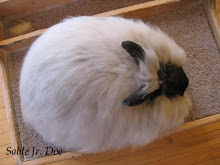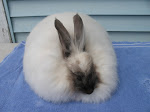As I mentioned several months ago, I embarked on a Giant breeding project focusing on the Black and White varieties. I acquired some purebred Giants and then actively started breeding them in with French and also some French/NZ crosses in order to boost size, weight, hardiness and breeding ability. The first crosses I did (F1 gen.) were all over the map with a huge disparity among litters. Some babies were large, some were small, some were furnished and some were not, some were robust, and others were frail. I weeded the first litters out ruthlessly, preserving only the heftiest, hardiest rabbits, and I disregarded wool almost completely since I knew from experience with the FA/NZ crosses that the wool would come back quickly and easily and that it was type and weight that would be most difficult to set.
The first generation produced turned out to be good breeders for the most part. Anyone who lagged in that department was promptly removed from the gene pool since I could not, under any circumstances, encourage poor parents. The wool on almost all of these rabbits was extremely out of balance as one would expect in a cross, and the second generation I produced was a combination of crosses with purebreds and also, in one or two cases, a combination of crosses with crosses that produced 'pure' giants, 'pure' French, and assorted combinations of both:).
I noticed a substantial improvement in the 2nd generation in terms of wool, and even though there were occasional well-typed animals there were many, many, MANY culls, and out of nearly 100 offspring I ended up only being able to save about 8. These 8 were large, hardy, and meaty with good type, and they had far fewer ear furnishings than the original animals. Right now these rabbits are growing out and should be ready for breeding next Fall. Hopefully the next generation will improve again, and there will be something to show over the next year or two.
I nearly gave up on the GAs after repeated breedings did not produce a large quantity of good stock at first. I was having to breed ridiculous amounts of litters to produce a tiny, working gene pool, and it was getting a little too prohibitive in terms of labor and cost:(. As this breed is generally new and unsettled, it will take a closed herd and intense breeding over a considerable length of time to get more consistent results, and the work involved with that is mindblowing to say the least, LOL.
Anyway, the traits that have been most frustrating up to this point are:
-massive appetites without any accompanying weight gain or improvement in meat condition (1 1/2 cups per day--at least--on some animals, without an appreciable increase in weight)
-heavy, HEAVY furnishings on some animals that were difficult if not impossible to maintain and resulted in chronic matting between the ears
-a tendency to slow down or stop eating entirely on or around the 4th month of growth despite a prime coat and no signs of slippage
-a lack of meat 'density', meaning that when I lifted even the largest animals up I felt no 'heftiness' or brick-like quality compared with other angoras or meat rabbits.
-the virtual impossibility of maintaining a GA in full coat due with just a slicker brush due to the density and multiple layers of the coat.
I have been trying to adjust for the excessive feed consumption by using only those rabbits who gain on smaller rations of feed (for ex. 1 1/4 cup instead of 1 1/2-2 cups), and I have been culling extremely hard for the kind of low maintenance ear furnishings that Louise Walsh (creator of the Giant Angora) originally intended for the breed. Correct Giant ears (according to the standard) are "lightly fringed and well tasseled", meaning that the bulk of the 'hair' is restricted to the tips and there is nowhere near enough wool on the ears to make them matt and stick together. They should not have English ears or head furnishings, in other words.
The tendency to go off feed is not unusual for Giants, from what I understand, particularly since they were derived from the German Angora which is bred to adhere to a strict 3 month growth/harvest cycle. People I know who have owned German Angoras say that they tend to reach a certain point and go off feed as well despite the fact that they do not molt. I have heard this attributed to the discomfort of a heavy coat and possible other factors, but the fact remains that a show rabbit (angora) must be able to go beyond three inches in order to be successful on the table, and they must be able to keep eating for a lengthy period AFTER hitting the prime phase so they do not lose meat condition and are able to make the most of the prime phase of their coats. I am going to select for longer-holding coats and also buns that are just plain good eaters and drinkers. An excellent eater will be able to put on the weight necessary to fill out, and a good drinker will display a healthier coat and much less of a tendency to woolblock.
As far as the meat density goes, it has often been said that an angora cannot achieve the 'hardness' of a meat breed, and this may well be true since much of the protein they consume goes toward wool growth. However, it is certainly possible for them to achieve very respectable meat condition as many current FAs, SAs, and EAs have shown, and I am sure it is possible to beef up the GAs as well with selective breeding and a constant leaning toward heavier, denser types.
The grooming for GAs is substantially more difficult than that of the French. Some Giants seem to have no more wool at each harvest than a French, but the denser ones in particular can be hard to approach with the slicker brush as it is next to impossible to get down to the base of the coat. A blower will be almost imperative for this breed on the showtable, and I suspect that as the coats get thicker it will be necessary to use the blower during regular grooming as well, reserving the slicker for only wool tips, face, feet, and ear furnishings.
Below are pictures of a few of the F2 FA/GA bunnies I produced this winter. I interspersed the photos with some of French Angoras of the same age (born at the same time) so you could see the difference in wool.
First is a black GA cross with a very clean head. Though there are next to no furnishings on this doe's ears, she is large, dense, and sturdy, and she will be able to produce litters with the correct furnishings when bred to a more heavily furnished buck. This doe had incredible density even at the age of 12 weeks. I took a closeup of her wool, (below) which has the kind of excellent crimp I would expect to see on a good Giant. There will only be two fiber types on this rabbit which make it incorrect for a Giant coat, but it's a good start.


And this is a photo of a black French Angora buck named Spang's Lusaka. He was born around the same time as the bunny above and is an excellent rabbit, but it is clear that he does not have the same wool type as the cross above, and not as much density as the cross at 12 weeks.
This is a Tort GA cross doe who is also going to have great wool with good crimp and density. I included two wool shots for this one---the first showing the multiple layers of wool coming in as the coat matures, and the second showing the overall texture and crimp of the coat.






This last photo is not of a GA, but of a purebred REW French doe. This is one of three fabulous REW does that were born in the barn this winter. All have beautiful, smooth type and wonderful wool, and they should be very competitive on the first senior coat. Two of the three girls are out of Spang's Zsa Zsa, one of my best does, and the third is out of Spang's Marin, another REW with NZ blood that produced both the third REW and Lusaka, the black buck. I included a close up of this doe's wool below, and there you can see the classic 'halo' of a French coat that is produced by the gap in length between the underwool and guard hair on a balanced coat. This doe is 12 weeks old as well.






























